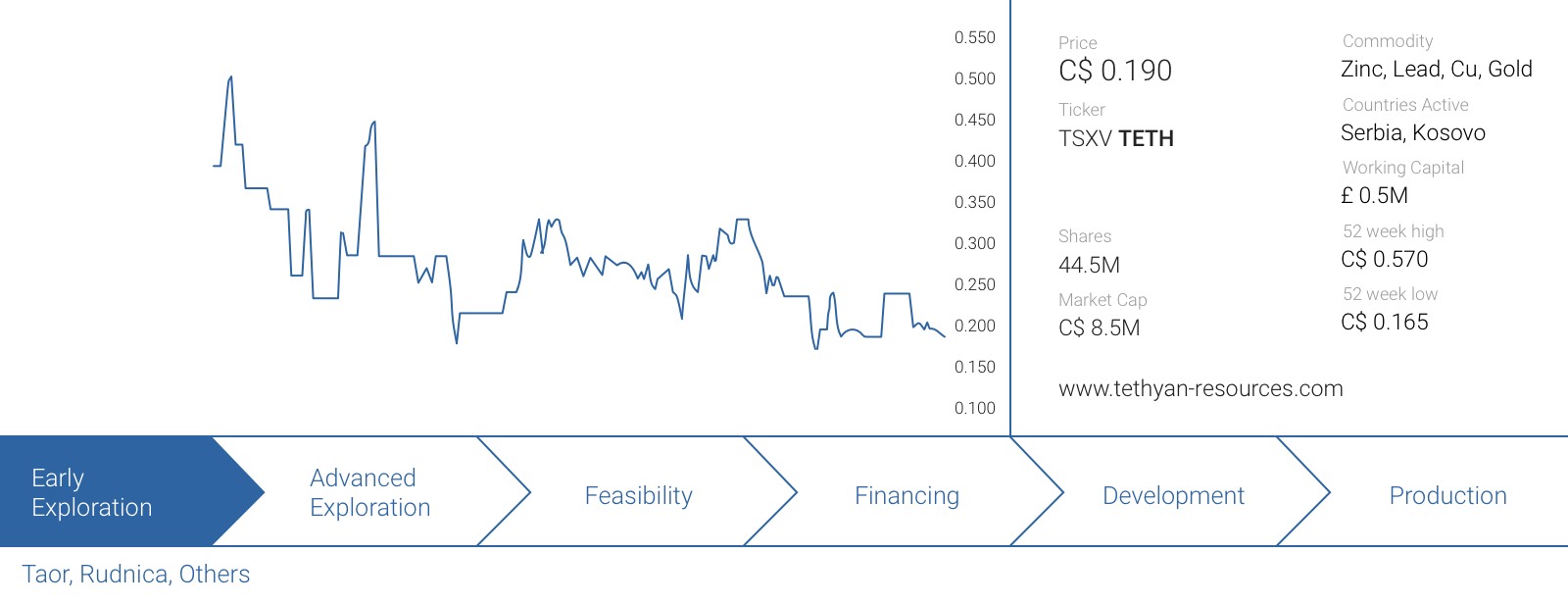Tethyan Resources (TETH.V) initially got a lot of attention and love from the market a few years ago when it made a new copper-gold porphyry discovery in Southwest Serbia. The Rudnica project combined long intervals with more than acceptable copper and gold grades, but due to the lack of expansion drilling, the currently known mineralized envelope remains relatively small. Tethyan realized drilling out a porphyry project probably wasn’t the best move to create shareholder value as it generally costs tens of millions of dollars to do so.
Tethyan started to re-think its strategy, and entered into an agreement to acquire the Serbian company “Taor” and its exploration licenses. Taor’s licenses are immediately adjacent to Tethyan’s existing land package, but seems to be more prolific for zinc and lead discoveries. And that could be an excellent strategy as exploring and developing (brownfields) zinc and lead projects is generally much cheaper than advancing huge porphyry projects.
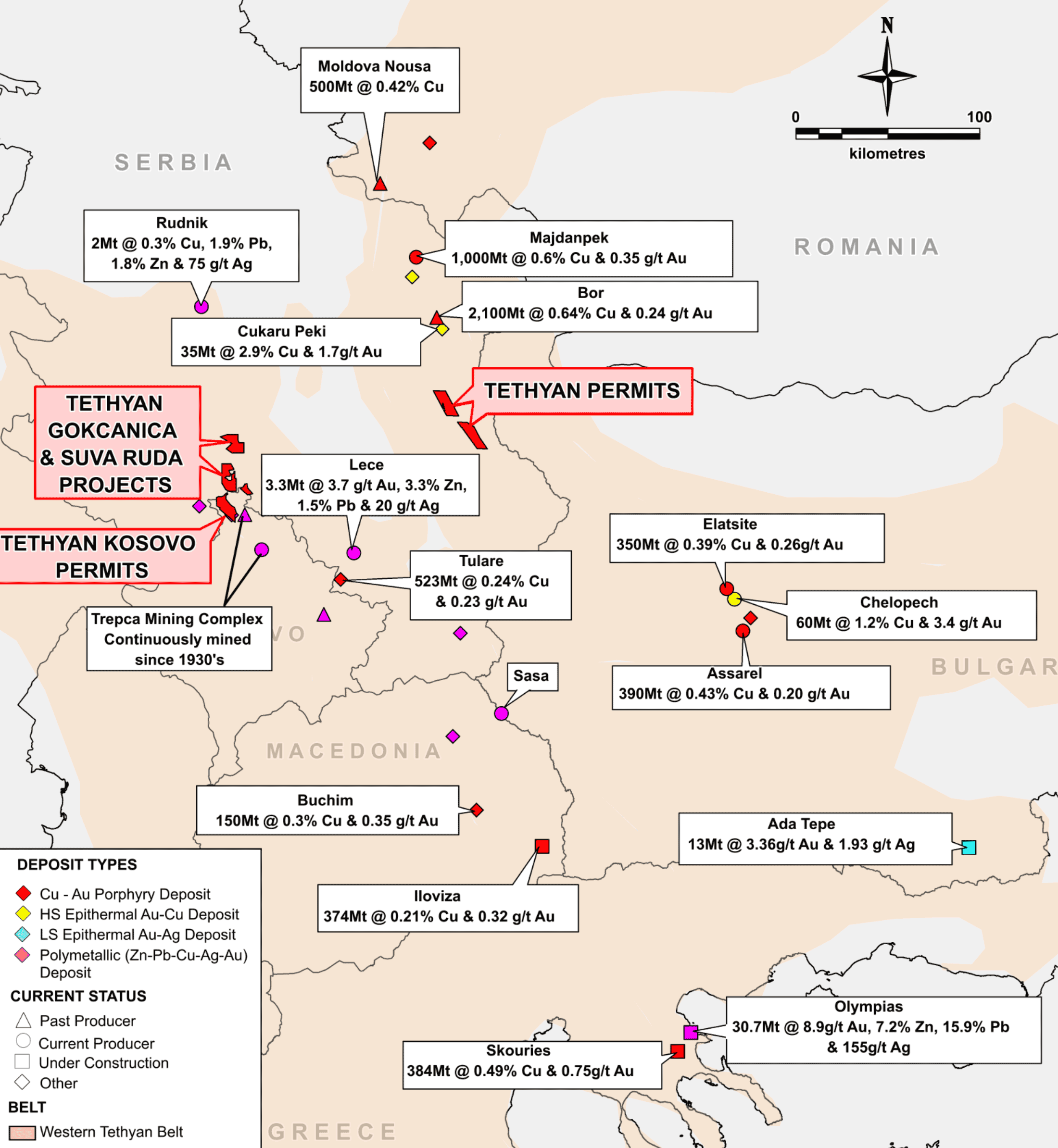
Why the Balkans? And why Serbia and Kosovo?
Most people remember or recognize Serbia and Kosovo from the war in the mid-90’s, and the focus only recently shifted to mineral exploration when Reservoir Minerals discovered the Timok project, a massive copper-gold deposit in Serbia. This wasn’t news to geologists, as the country already had several state-owned copper-gold porphyry mines of which Bor was the most important one, with a total resource of 2.1 billion (!) tonnes at 0.64% copper and 0.24 g/t gold. The nearby Majdanpek-project also contained approximately 1 billion tonnes at 0.6% copper and 0.35 g/t gold, so it was pretty clear the country was pretty well endowed with mineralization. This was confirmed by the maiden inferred resource estimate on the Lower Zone of the Timok project where Nevsun Resources (NSU, NSU.TO) and Freeport McMoRan (FCX) unveiled an inferred resource of 31.5 billion pounds of copper and almost 10 million ounces of gold in an orebody of 1.7 billion tonnes.
On top of that, after the Yugoslavian war, Serbia became a stable nation with a pretty good legal framework (which was a requirement for the European Union to even start negotiations with Serbia). On top of that, the country is very open for foreign investment, and has a very attractive tax regime in place: the corporate tax rate is just 15%, and mining companies pay a 5% NSR to the government. A good deal overall, and Serbia succeeded in attracting foreign companies to invest in exploration programs, and the recent mining code (2015) could compete with most other mining jurisdictions.
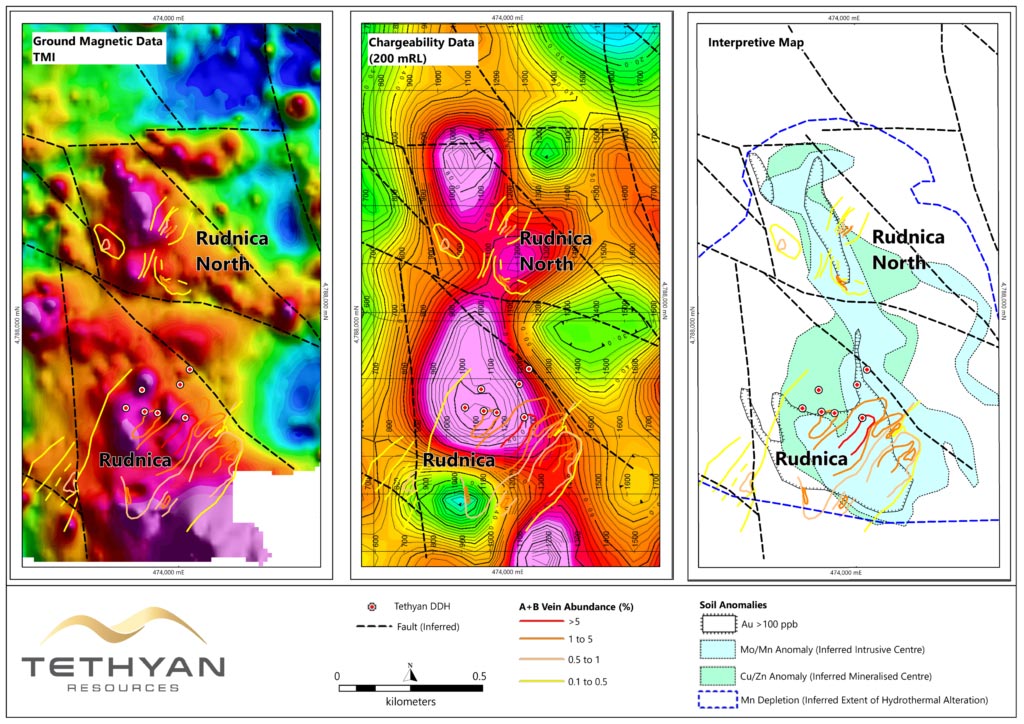
Although Tethyan made a very interesting copper-gold porphyry discovery, it’s important to realize it’s not exploring in the same belt as the large Bor and Majdanpek projects, as in Serbia the Tethyan belt is split up into smaller belts with slightly different age rocks. The western zone of the Tethyan belt, where Tethyan’s main projects are located, is generally seen as a lead and zinc destination because it includes the Trepca Mining District which was the largest producer of lead and zinc in Europe during the 20th Century. More recently, some pretty good copper-gold porphyry deposits have also been discovered in the belt, such as Eldorado Gold’s Skouries project in Greece, however the area still isn’t well known as a large copper-gold porphyry exploration camp.
Don’t get us wrong, the potential for new porphyry discoveries definitely exists (as was evidenced by the discovery of the Rudnica copper-gold project in 2016 and 2017. Although most holes were drilled pretty close to each other which means we don’t really have a good idea yet about the total size of the mineralized envelope), it does look like there’s something really interesting going on there. It very likely won’t be as massive as the Bor and Majdanpek mines, but there’s definitely enough ‘smoke’ to warrant additional follow-up exploration programs (see later).
Geology and mineralization doesn’t respect a country’s borders, so there’s no reason why Serbia’s Raska mineralization wouldn’t continue towards and into Kosovo. This is indeed the case, and on the other side of the border, Kosovo’s portion of the Trepca Mining District is very well-known for its zinc-lead mineral endowment as well. The Trepca District zinc-lead-silver deposits could be described as intermediate sulphidation epithermal vein and breccia type, similar to the Fresnillo (FRES.L) mine in Mexico (mined since 1960’s, remaining measured and indicated resources of 38Mt at 3 % zinc, 1.5 % lead, 352 g/t silver, 0.85 g/t gold) and a number of mines in Peru such as Trevali’s (TV.TO) Santander mine.
Plenty of reason for Tethyan to look across the border for more projects, and the company now has two Kosovo projects in its portfolio.
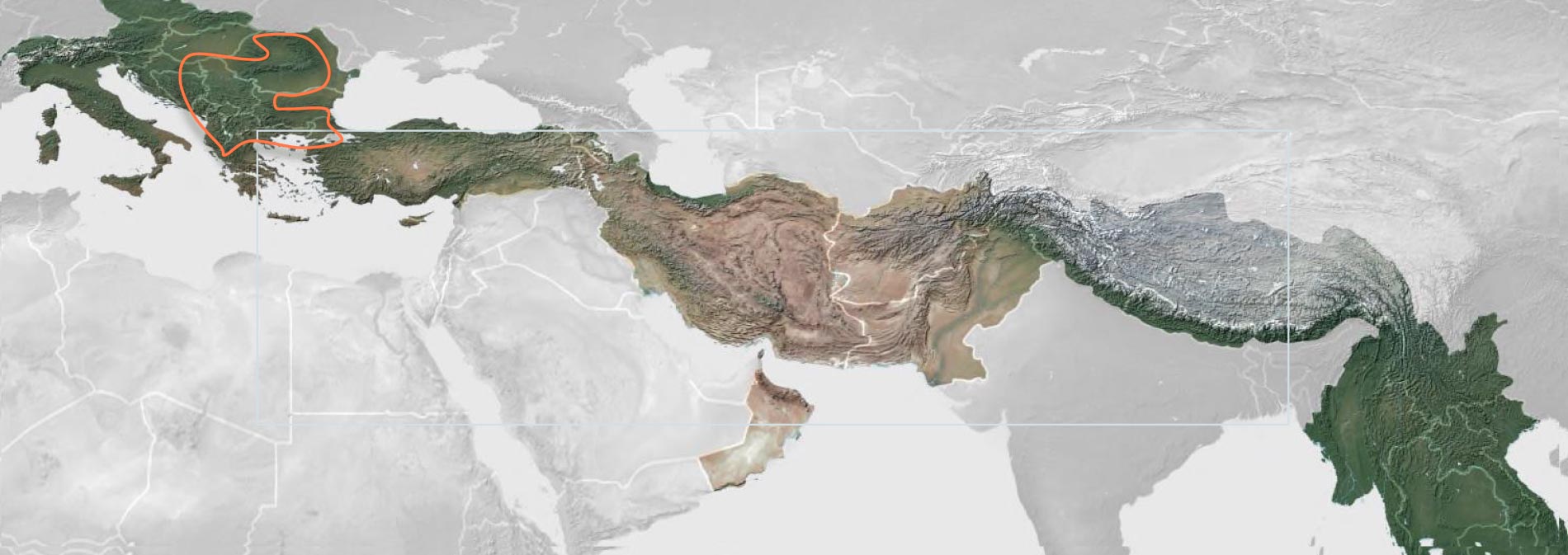
The Serbian division
Taor
The Taor licenses are the most recent addition to Tethyan’s project portfolio, but it appears they will be one of the company’s main targets in the foreseeable future as Tethyan has already unveiled the exploration plans for these recently acquired areas.
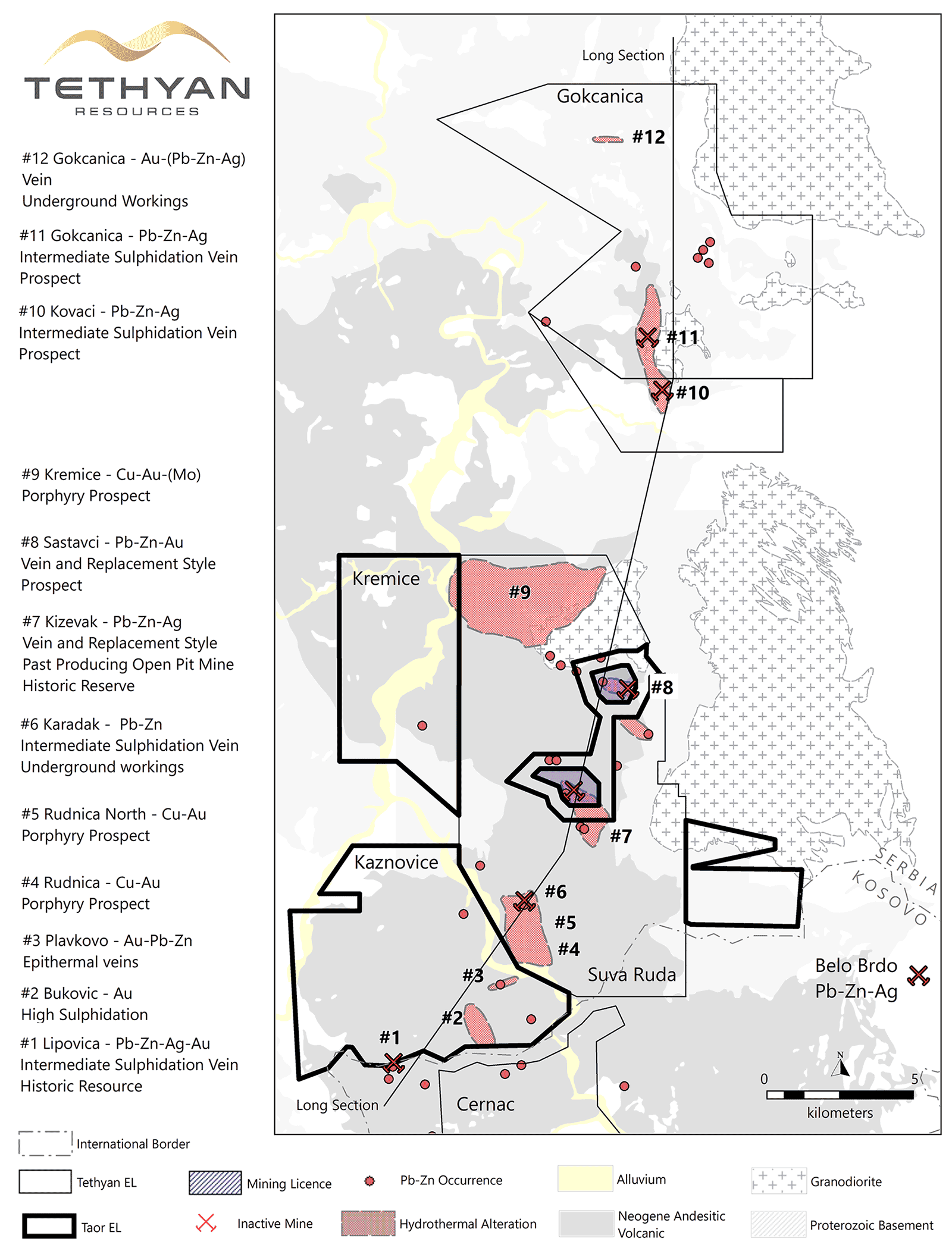
The Taor licenses are extending over a surface area of approximately 100 square kilometers, directly adjacent to the Suva Ruda exploration license (see later) in the Southernmost part of Serbia. The Taor licenses are two different exploration licenses: Kremice and Kaznovici, and have been acquired for 12 million shares (7 million shares have been issued now, a second 5M share payment will be made in 12 months) and 250,000 EUR in cash (of which half has already been paid, with the second tranche of 125,000 EUR payable within three months).
Kremice
The Kremice license is located on the northwestern side of the Suva Ruda license and is literally surrounding an area that hosts two past-producing zinc-lead mines: Kizevak and Sastavci. We couldn’t find historical data on the Sastavci mine, but the existing (read: remaining) documentation on the Kizevak project seems to be pretty interesting at first sight. This was a state-owned and state-run mine which excavated approximately 2 million tonnes at an average grade of 5% Zn+Pb from an open pit. The rock was subsequently trucked to a nearby mill (remember, the licenses are located in a real lead and zinc district) where a lead and zinc concentrate was produced and subsequently shipped to smelters.
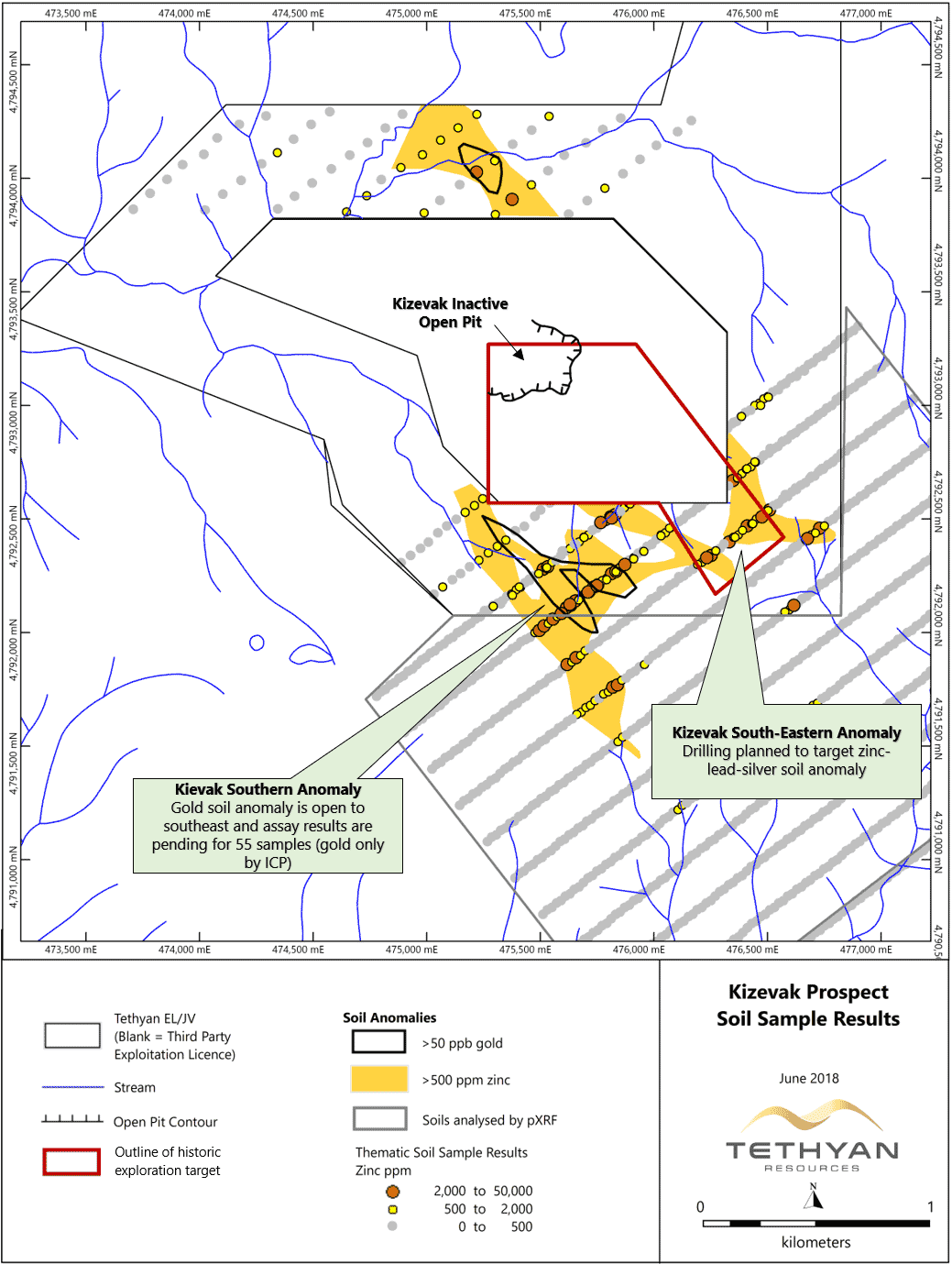
Although Tethyan Resources doesn’t own these historical mines, it usually is a good idea to start exploring in the immediate vicinity. The Serbian state-owned companies were run to maximize the jobs numbers, and not to optimize the production of metals, so we doubt there has been a thorough and efficient drill program in the wider region of the two mines to test the potential for additional mineralization.
A Serbian company acquired those two past-producing mines and completed in excess of 12 kilometers of underground adits and almost 12,000 meters of drilling between 2008 and 2011 to figure out the extent of the mineralization and to define a new mineral resource. That’s interesting, and according to the available data, Tethyan says the mineralization and resource estimate from the Kizevak mine appears to be continuing onto the Kremice license for ‘at least 250 meters, and appears to remain open’.
Tethyan has completed a stream sediment and soil sampling program at Kremice, and the assay results of the 400 samples indicated a large anomaly of 1200 meters by 600-1200 meters next to the historic Kizevak mine. The assayed samples show highly anomalous values for zinc, lead, silver and gold (indicating extensions of the Kizevak mine veins) which is within walking distance from another 1000 X 1000 meter area with noticeable copper, gold and molybdenum, and depleted manganese and zinc which are key pathfinders to copper-gold porphyry deposits.
Kaznovici
The Kaznovici license is located to the southwest of Suva Ruda, and immediately adjacent to the Rudnica porphyry target where Tethyan successfully intercepted thick intervals of copper-gold mineralization. Despite this, the main reason for acquiring Kaznovici doesn’t appear to be the copper-gold target, but the previously explored Lipovica zinc-lead-gold project. That project was explored by the British and the Yugoslavians before the Balkan war started, but has been ‘overlooked’ ever since.
The Kaznovici land package hosts at least three known anomalies with poly-metallic characteristics. Tethyan has done a great job in summarizing the merits of those three properties in its most recent press release, and rather than just rehashing what the company released, you might as well go straight to the source and read about the three anomalies here.
The Kaznovice exploration license needs more work before it’s drill-ready, and Tethyan Resources is planning to complete an infill soil sampling program to define potential drill targets. The main focus will be on the Kremice part of the Taor acquisition.
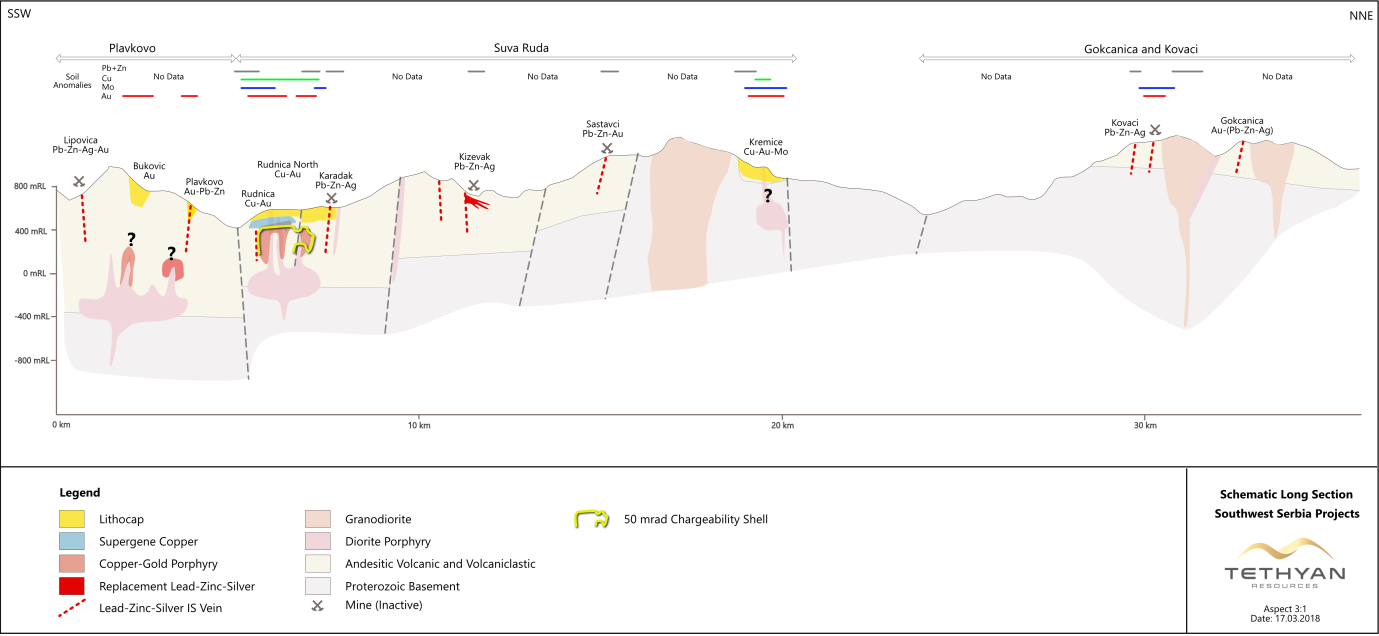
Suva Ruda (Rudnica)
The acquisition of Taor has solidified the position of Tethyan Resources in this Raska lead and zinc mining district and the greater Raska-Trepca Mining District (Trepca technically is Kosovo-based, but as the Serbia-Kosovo border is pretty recent, a case could be made to call the Serbian side of the border Trepca as well), and allowed the company to expand its land position to approximately 280 square kilometers. Although the focus now appears to be on the zinc and lead rich zones of the greater Suva Ruda area, Tethyan originally explored for copper-gold porphyry systems, and was very successful in doing so.
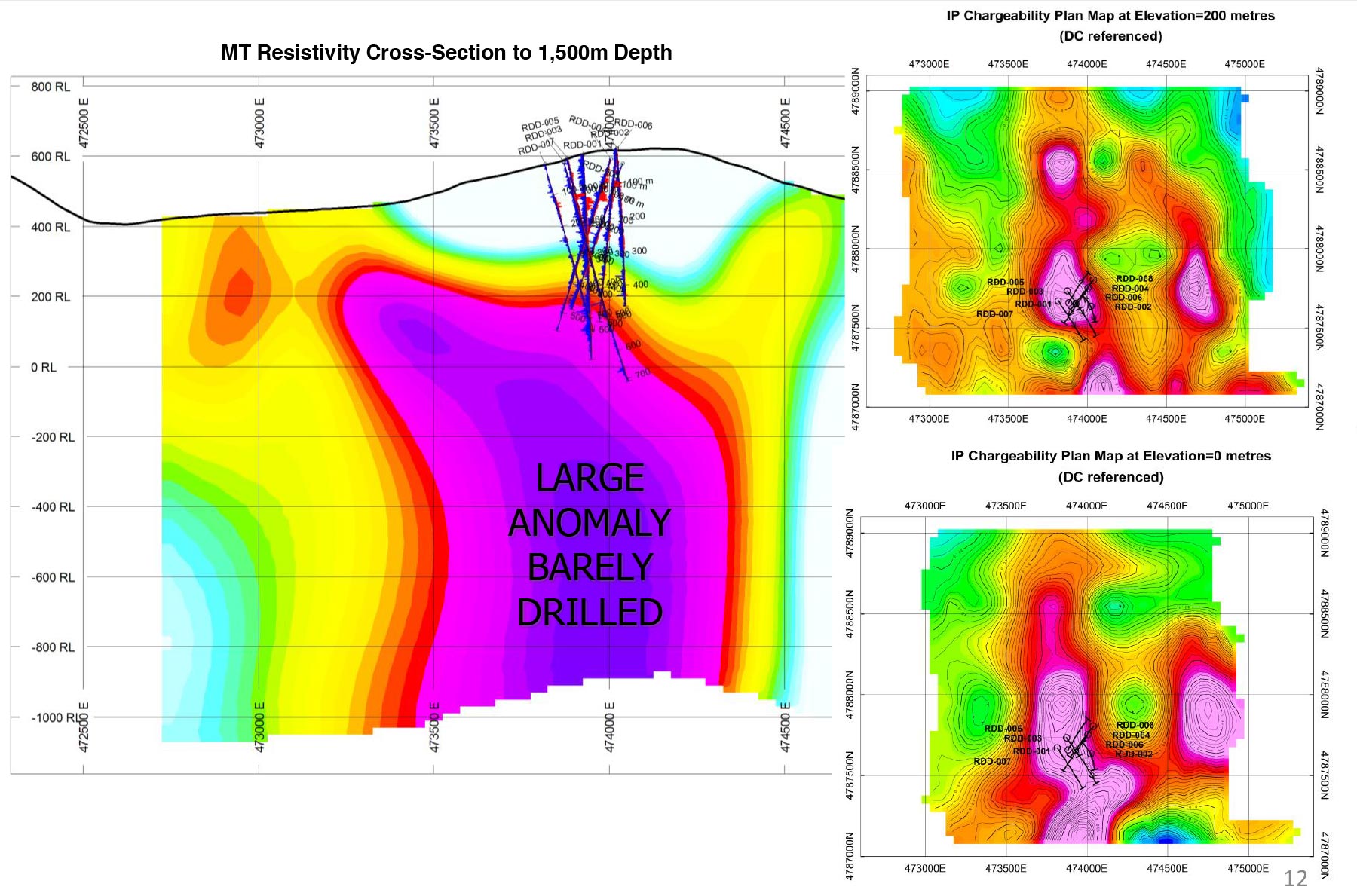
Close to the Kosovo border, Tethyan discovered a large anomaly and an exploration program designed to drill-test this anomaly punched 8 holes in the ground at Rudnica. The assay results were absolutely excellent, as 4 holes encountered mineralization from the surface. Tethyan reported grades as a gold-equivalent number, but we think a case could be made to consider the project as a copper project with a gold credit.
As you can see on the previous image, the mineralization appears to be widespread and although drilling remains limited to the immediate vicinity of the original drill holes, the Rudnica project definitely needs more exploration to really figure out what’s underneath the surface. But as we mentioned in our introduction, drilling 600-meter-deep holes are pretty expensive and drilling out Rudnica to get to a decent sized inferred resource estimate would cost a fortune. We agree with the company’s view it might not be the best idea to tackle the Rudnica project on its own, and it would be best to involve a partner to share the cost.
As Tethyan now focuses on its zinc-lead projects, it could make sense for Tethyan to find a partner with deep pockets. The recent announcement by Nevsun and Freeport about a 31.5 billion pound copper resource elsewhere in Serbia might help to attract a partner (note Nevsun’s Timok project is located in Northeastern Serbia, where the mineral endowment (more copper-rich) is a bit different than where Rudnica is located). For now, Tethyan Resources can afford to just ‘sit’ on the exploration license as the annual milestone payments of 100,000 EUR in 2018 and 2019 are manageable, and the final 6M EUR payment is only due in 2022.
Tethyan will immediately start drilling at Kizevak (Kremice License)
‘No time to waste’, CEO Baker must have thought. And in the same press release announcing the definitive acquisition of the Taor licenses, Tethyan already mentioned it would immediately start a 1,000-meter drill program on the Kizevak prospect. Remember, this is the zone immediately adjacent to the past-producing Kizevak zinc-lead-silver mine.
The drill program will consist of a minimum of 1,000 meters of core drilling in 5-7 holes with an average depth of 150-250 meters. We enquired with CEO Fabian Baker about the cost of this drill program, and he reckons the total cost (drilling + assaying) will be approximately C$175 per meter. Drilling isn’t expensive in Serbia, and as price quotes are made in Euro, a strong Canadian Dollar actually is a benefit to the company.
As Tethyan will be chasing the low hanging fruit from the extensions of the Kizevak open pit, this could be a very high impact drill program. Tethyan is also in the process of acquiring historical (drill) data on the property, and this could further fine-tune its exploration programs.
The Kosovo Division
Last month, Tethyan announced its Kosovo subsidiary (which is 95% owned by Tethyan, 5% owned by Tethyan’s local Managing Director who helped Lydian International advance its Draznje project between 2006 and 2009) was awarded a new exploration license for a 75 square kilometer project called Bistrice (this boosted the size of the total land package in Kosovo to approximately 160 square kilometers). The exploration license remains valid for an initial three years, but could subsequently be extended three times for a 2-year period. Long story short, the exploration license could remain in good standing for 9 years. However, every time an exploration company tries to extend an exploration license, it needs to relinquish 50% of the size of the land package.
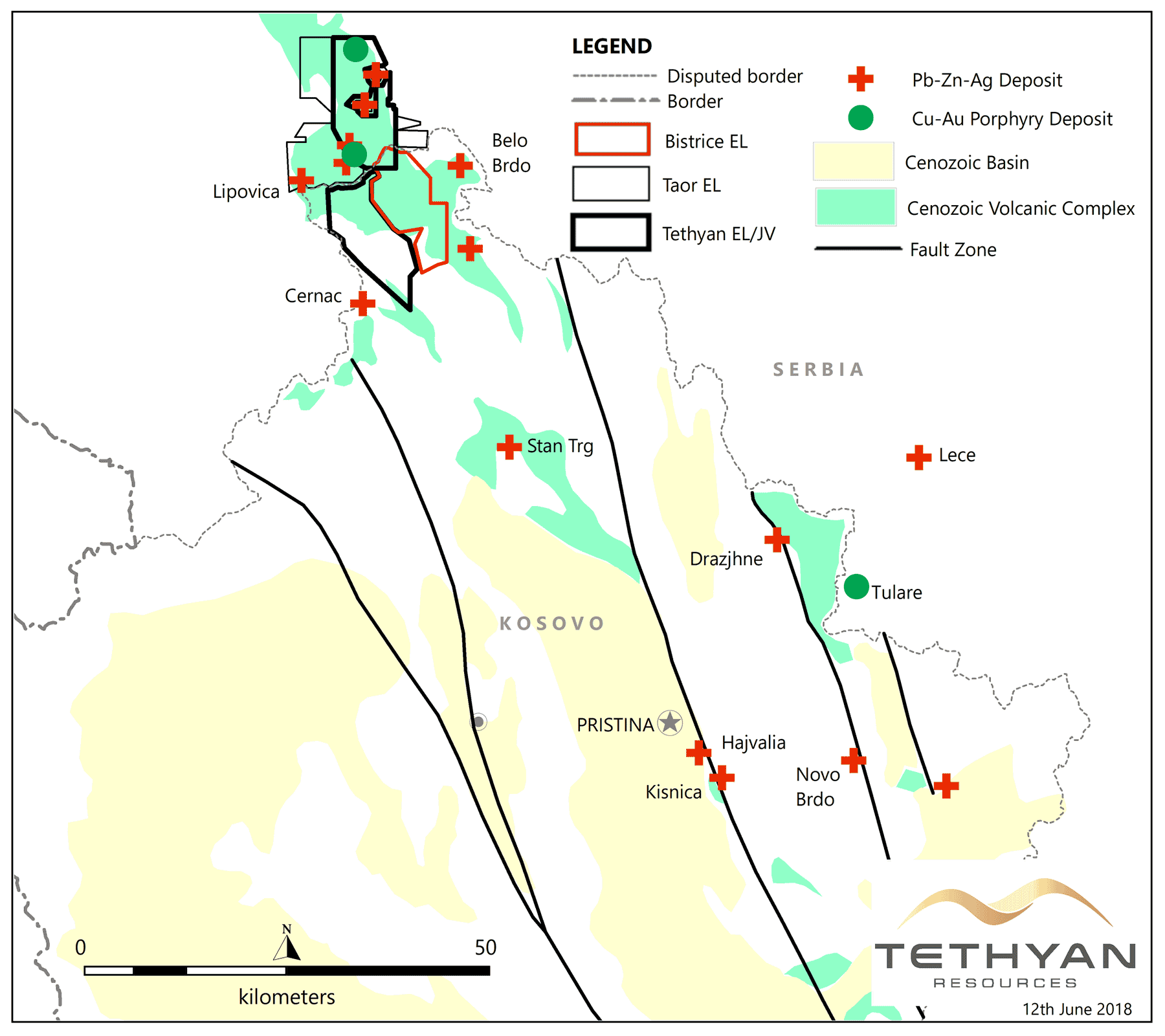
This strengthens Tethyan’s position in the Trepca mining district where the company has been focusing on copper-gold porphyry deposits as well as specific zinc-lead-silver deposits. As you correctly notice, these are the two same types of mineralization as Tethyan encountered right across the border in Serbia.
Being awarded this exploration license also means Tethyan has now pretty much locked up the entire region. As you can see on the next map, pretty much all of its projects in Southwest Serbia are now directly adjacent to each other.
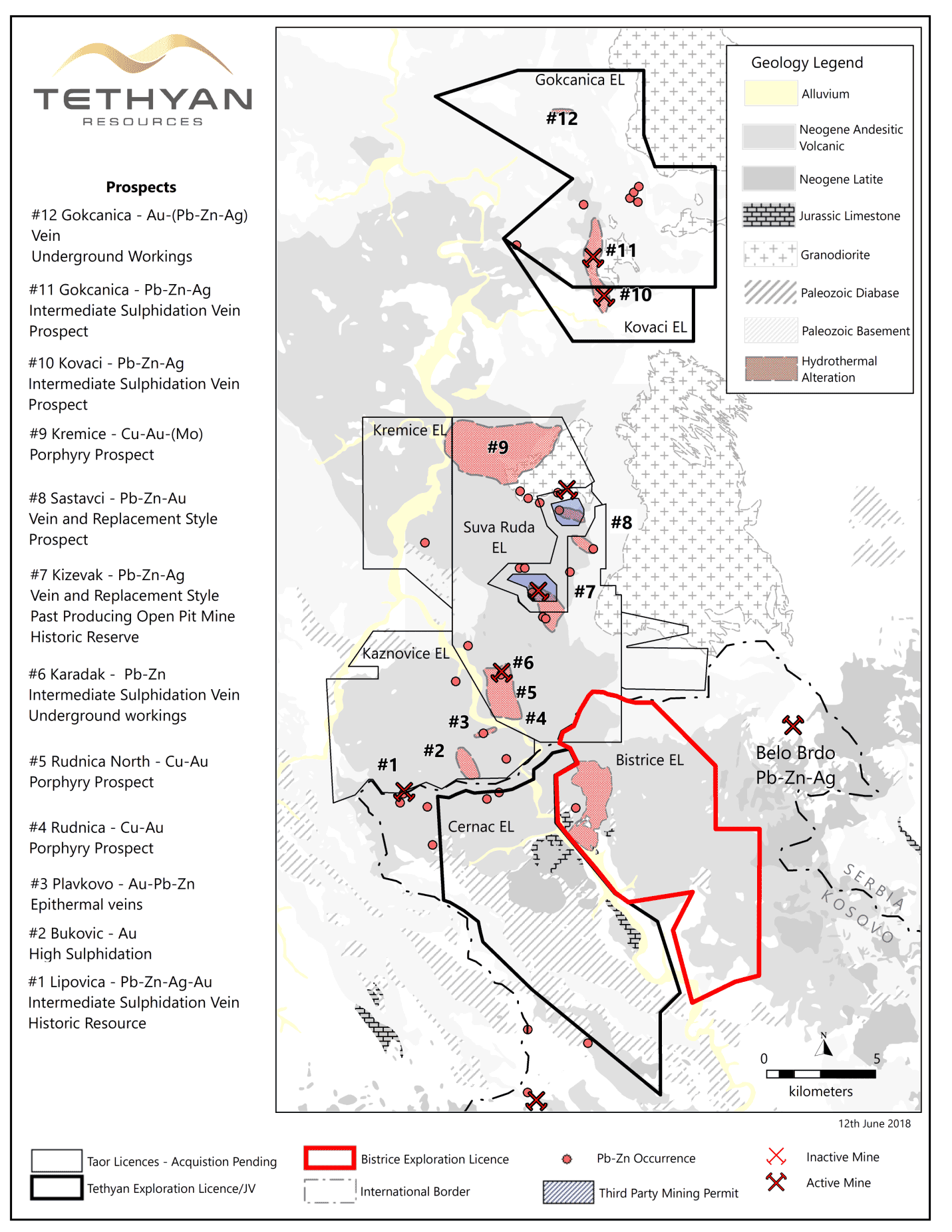
The financial situation and share count
Tethyan’s CEO is running a very tight ship and doesn’t like to waste money. The company raised C$1.2M in a private placement at C$0.25 in April, and this should boost the working capital position to approximately 0.5M GBP (as Tethyan’s official headquarters are in Jersey, the company is reporting its financial results in British Pounds).
An existing 593,000 GBP loan was converted earlier this week upon closing the Taor acquisition (this was a requirement before the lenders would agree to the conversion into equity). This resulted in an additional 4.05M shares being added to the share count. Adding the 7M shares as consideration for the Taor project, Tethyan’s current share count is approximately 44.5 million shares, giving the company a market capitalization of C$8.5M based on C$0.19 per share.
It’s important to note Tethyan has some strong shareholders. In late-2016 TSX-V listed company Southern Arc Minerals (SA.V) made a significant investment in Tethyan, acquiring 29.9 % of the company (due to UK Takeover Panel rules they can’t easily go over 30 %). Southern Arc’s business model is to take a major share position in early-stage junior explorers and support them by providing financing and expertise to grow the company.
Therefore, Southern Arc has appointed 3 people to the Board of Tethyan, with the remaining 2 board members being Fabian Baker (President and CEO, and founder of Tethyan in Serbia) and Dr. Radomir Vukcevic who was the previous owner of Taor. Between Southern Arc and Tethyan’s directors they own approximately 47 % of the company, so it is fair to say that the objectives of the management and its key shareholder are definitely aligned with other shareholders.
Management
Fabian Baker – Executive Director, President and CEO
Fabian is a geologist with significant experience in the Western Tethyan Mineral Belt, including leading grassroots exploration through to completion of Bankable Feasibility. Previous roles include Chief Geologist at Lydian International’s newly discovered Amulsar gold deposit in Armenia and Exploration Manager for Royal Road Minerals whilst the company was focused in Turkey. He founded the private company that secured exploration assets in Serbia which was subsequently acquired by Tethyan and led to the Company’s entry into the Balkan region. He was the Chief Operating Officer of Tethyan for two years since early-2016, during which time he successfully acquired and developed significant exploration assets, built a highly capable team and implemented the Company’s business strategy in the region. He has a Bachelor of Science in Applied Geology from the Camborne School of Mines.
John Proust – Non-Executive Chairman
John received the designation of Chartered Director (C.Dir.) from McMaster University, Directors College, Michael G. DeGroote School of Business. He is the founder and principal shareholder of numerous public and private companies. He has directed, managed and advised public and private companies regarding corporate strategy and structure, debt and equity financing, mergers and acquisitions, and corporate restructuring since 1986. Mr. Proust has held senior positions and served on the boards of many private and TSX-V/CSE listed companies. He is currently Chairman and CEO of Japan Gold Corp., Chairman and CEO of Southern Arc Minerals Inc., Chairman of Canada Energy Partners Inc., Interim President & CEO and a director of Outrider Energy Corp., and a director of Q Investments Ltd.
John Carlile – Non-Executive Director
Mr. John Carlile is a geologist with more than 35 years of experience in the resource industry. Mr. Carlile has held senior executive and director positions with both major and junior resource companies, including President of Indonesian and Philippines subsidiaries of Newcrest Mining Limited, and Chairman of Singaporean public listed oil company Pearl Energy Ltd. As a geologist, Mr. Carlile has a proven track record of mineral discovery and business building in Asia, most notably as Exploration Manager, Asia for Newcrest Mining Limited when it discovered its Gosowong mine. Mr. Carlile has served on the boards of several resource companies, and currently holds the position of director of Japan Gold Corp., Tethyan Resources plc, and Equator Gold Ltd. He holds a BSc in Geology from University of Reading, England, and an MSc in Mineral Exploration from the Royal School of Mines, Imperial College, University of London. Mr. Carlile is a Fellow of the AusIMM and a Fellow of the Geological Society of London.
Andrew Tunningley – Exploration Manager
Economic geologist with over 14 years field based experience in grassroots to resource estimation stage gold, silver, copper, lead-zinc, iron, coal and agro-mineral exploration. Skills include geological mapping, sampling, drilling; project design and management; project evaluation and due diligence, and QAQC program design and monitoring. Broad range of interpretation skills including field data, geophysical surveys and satellite imagery. Experience with a wide range of precious (gold, silver), base metal (copper, lead, zinc) and coal (thermal and coking) deposit types in over 30 countries within Central and South East Asia, Middle East, North and South America, Europe and Africa.
Conclusion
Tethyan’s shift to focus on zinc-lead projects around past-producing base metal mines might be a good idea as we have the impression this could enable the company to spend its money more efficiently, whilst the upcoming drill program could have a high impact on the company as a whole.
Previous exploration programs as well as a recent sampling program that was conducted as part of the due diligence phase of acquiring the Taor land packages show great potential for the projects. Drilling will start imminently, and we expect to see initial assay results in the first half of August. With a current market cap of C$8.5M, Tethyan doesn’t need to find much to justify its current market capitalization. If some of the historical drill intervals at Kizevak could be repeated, Tethyan could quickly start to ‘build tonnes’ and think about re-opening a mine in the Trepca Mining District.
Disclosure: Tethyan Resources is a sponsor of this website. We have a long position. Please read the disclaimer
